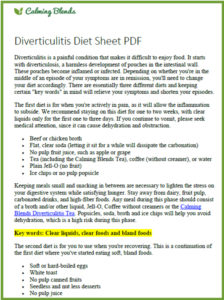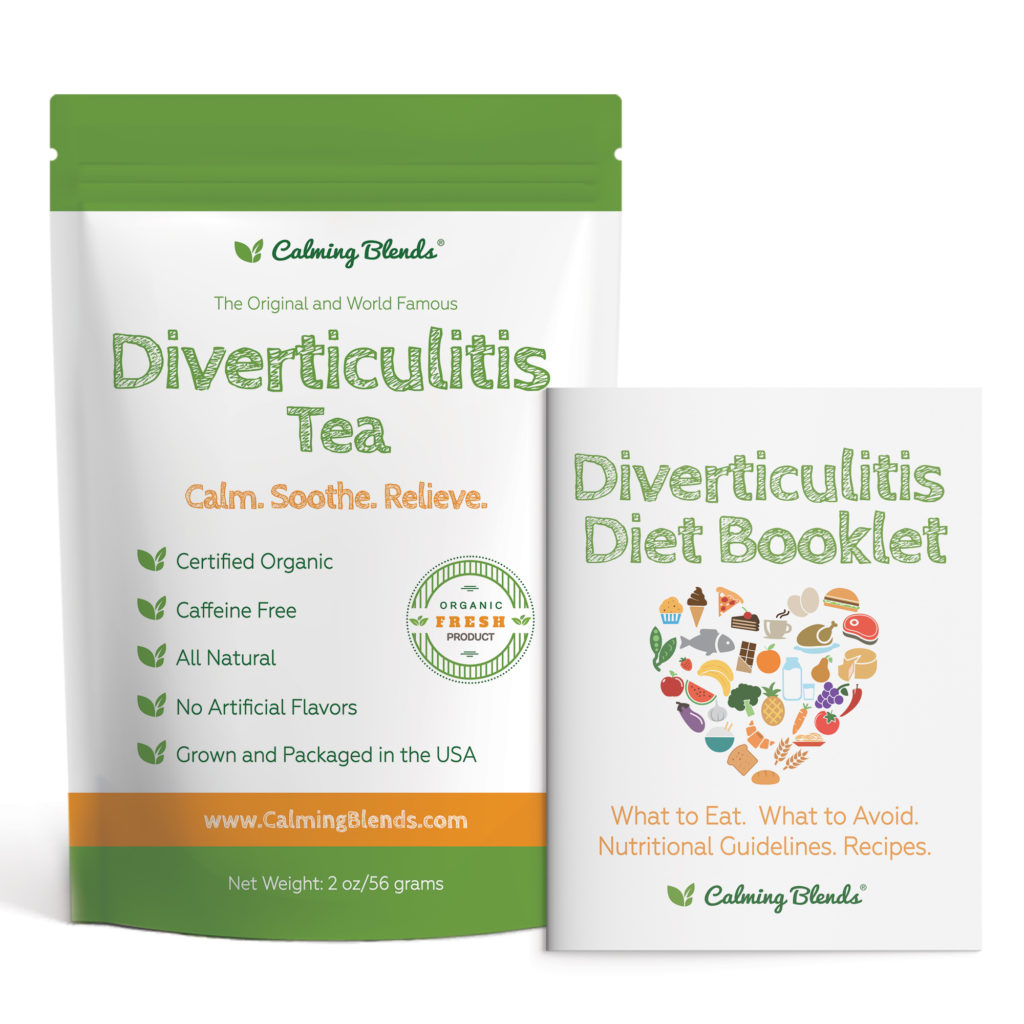Click here to download the Diverticulitis Diet Sheet PDF Version.

Diverticulitis is a painful condition that makes it difficult to enjoy food. It starts with diverticulosis, a harmless development of pouches in the intestinal wall. These pouches become inflamed or infected. Depending on whether you’re in the middle of an episode of your symptoms are in remission, you’ll need to change your diet accordingly. There are essentially three different diets, and this Diverticulitis Diet Sheet serves as a handy reference guide for when you’re unsure what to eat during a flare-up or simply need some guidelines.
Liquid Diet for Diverticulitis
The first diet is for when you’re actively in pain, as it will allow the inflammation to subside. We recommend staying on this diet for one to two weeks, with clear liquids only for the first one to three days. If you continue to vomit, please seek medical attention, since it can cause dehydration and obstruction.
- Beef or chicken broth
- Flat, clear soda (letting it sit for a while will dissipate the carbonation)
- No pulp fruit juice, such as apple or grape
- Tea (including the Calming Blends Tea), coffee (without creamer), or water
- Plain Jell-O (no fruit)
- Ice chips or no pulp popsicle
Keeping meals small and snacking in between are necessary to lighten the stress on your digestive system while satisfying hunger. Stay away from dairy, fruit pulp, carbonated drinks, and high-fiber foods. Any meal during this phase should consist of a broth and/or other liquid, Jell-O, Coffee without creamers or the Calming Blends Diverticulitis Tea. Popsicles, soda, broth and ice chips will help you avoid dehydration, which is a high risk during this phase.
Phase I Keywords: Clear liquids, clear foods and bland foods
Low Residue Diet
The second diet is for you to use when you’re recovering. This is a continuation of the first diet where you’ve started eating soft, bland foods.
- Soft or hard-boiled eggs
- White toast
- No pulp canned fruits
- Seedless and nut less desserts
- No pulp juice
- Low-fiber cereals with milk
- Cheese
- Yogurt
- Smooth peanut butter
- Tender meats: beef, poultry, fish etc. as long as they can be cooked until tender
- Plain carbohydrates: rice, noodles or macaroni
- Skinless, well-cooked vegetables
During this phase, you have more foods you can choose from. Meals should consist of a protein, a dairy or grain, fruit or vegetables, and a beverage. Feel free to stick with this diet for as long as you feel pain, diarrhea and vomiting. The philosophy here is “listen to your body.”
Phase II Keywords: Low-fiber, bland and soft foods (skinless fruits and vegetables, soft dairy and tender protein)
High Fiber Diet
Finally, there’s the third phase. This diet is for when you no longer have symptoms. To avoid constipation, which causes the inflammation, you must increase your fiber intake. By introducing one high-fiber food at a time each day, you get to adjust slowly and observe whether or not certain foods cause pain to return. That way, the fiber is not excessive nor a shock to your digestive system.
- Brown rice/wild rice
- Fruit with pulp
- Dried beans or lentils (legumes)
- Vegetables, cooked however you’d like, or raw
- Whole grain breads and cereals
- Beef, poultry, fish and other meats
- Eggs
- Cheese, yogurt and other dairy products
A good meal plan with this diet is a grain, a protein (such as meat or eggs), and fruits or vegetables. Keep in mind that legumes are a great source of protein as well as fiber.
Phase III Keywords: Foods with fiber (legumes, nuts, seeds, vegetables, whole grains), dairy, meat, fruit
During an episode of diverticulitis, diet can make all the difference between suffering from symptoms of pain and dehydration and feeling back to normal. Phase 1 consists of clear liquids, clear and bland foods, in much. Phase 2 consists of low-fiber bland and soft foods, while Phase 3 consists of foods with fiber. Remembering these key words will help you ease your digestive system and find out which foods allow you to live relatively symptom-free.


